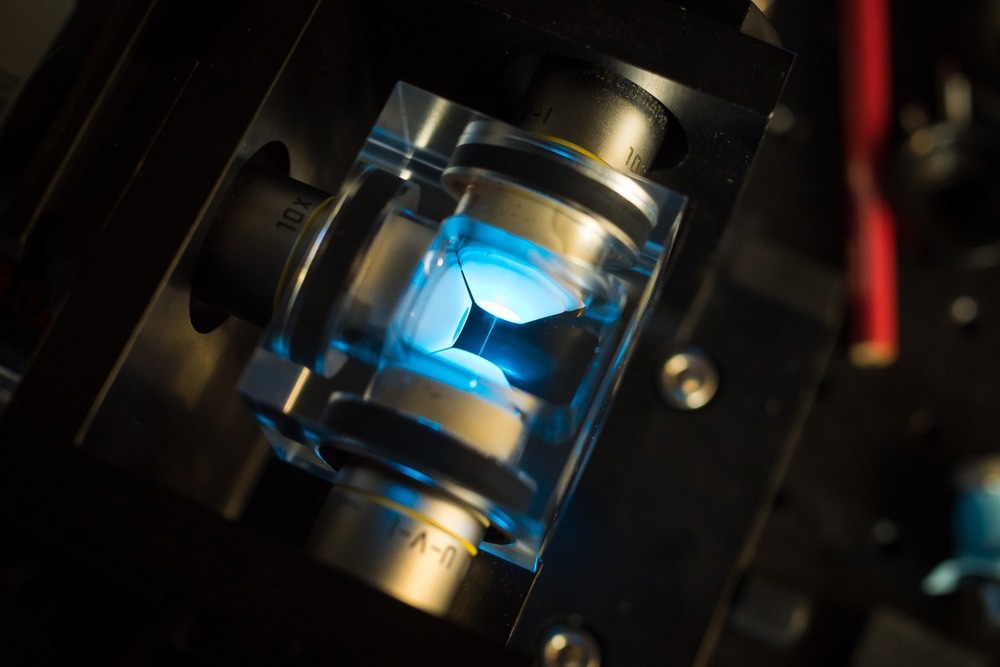In a recent study published in Nature Communications, a team of researchers evaluated the variations between Gaussian and lattice light sheets related to beam homogeneity, axial precision, transverse resolution, and photo-bleaching, using computations and experimental measurements on fixed cells.

Study: A quantitative analysis of various patterns applied in lattice light sheet microscopy. Image Credit: Micha Weber/Shutterstock.com
The researchers demonstrated that different optical lattice lighting patterns can be adjusted to highlight axial precision or visual sectioning. They also presented a method to obtain high resolution and low noise images by spectrally fusing successive acquisitions of various lattice light sheet patterns with matching optical characteristics.
Potential of Light Sheet Microscopes
Images of biological materials of different sizes, ranging from individual atoms to whole organisms, are obtained using light sheet microscopy.
Light sheet microscopes enhance imaging speed and reduce photo-toxicity. Only a thin plane of the sample is illuminated during light sheet microscopy. This eliminates out-of-focus illumination, decreases photo-bleaching, and improves the signal-to-noise ratio (SNR) compared to epifluorescence and optical microscopy.
Limitations of Light Sheet Microscopes
The axial resolution of a light sheet microscope and the visible field of view are inversely proportional to each other when equipped with Gaussian beams. By adopting axially structured illumination patterns, light sheets depending on optical lattices provide better axial resolution and beam homogeneity than Gaussian beams. These benefits come at the expense of the specimen absorbing more light and the illumination pattern being less axially constrained.
Using cylindrical lenses, the most effective light sheet microscopy techniques concentrate a Gaussian beam onto a laterally stretched sheet. This approach has an inherent trade-off between the light sheet's propagation length and thickness. Greater optical sectioning and axial resolution are offered using thinner Gaussian light sheets but at the expense of a shorter propagation length and a narrower field of view.
Strategies to Enhance Axial Resolution and Optical Sectioning in Light Sheet Microscopes
Structured light sheets, such as Bessel beams and optical lattices, can be employed to overcome the limitations of light sheet microscopes.
Hybrid beams composed of non-diffracting and Gaussian beams can be produced with the illumination pattern constrained to a single plane.
Depending on the imaging objectives, the user can adjust the illumination pattern to enhance propagation length, optical sectioning, or axial resolution by varying the width of the attenuation envelope at the sample.
Evaluation of Optical Lattice Illumination Patterns for Enhanced Axial Resolution and Optical Sectioning
Optical lattices have identical beam waists and optical transfer functions (OTF) compared to Gaussian beams. The performance of the equipment using square optical lattices and focussed Gaussian beams is identical.
Shi et al. evaluated and reported the benefits and drawbacks of lattice light sheets against gaussian beams. They performed actual observations on diffraction-limited beads, cellular architectures, and optical models. The researchers showed how structured light sheets can be modified to perform similarly to a Gaussian system by adjusting the bounding envelope at the sample.
Shi et al. evaluated the OTF and Fourier Plane Correlation (FPC) to analyze the spatial frequency relationships within images at various points along the beam propagation length. They also investigated light sheets with similar propagation lengths.
Research Findings
In this research, the trade-offs of various beam patterns employed in light sheet microscopy were examined using simulation models and practical observations. Real-space FWHM comparisons, frequency space OTF comparisons, and FPC were used to evaluate beam performance while imaging different subcellular structures in living and fixed cells at varying emitter densities and signal-to-noise ratios.
When compared to Gaussian or flat-top beams, square lattice and hexagonal lattice beams consistently outperformed them in axial resolution and beam homogeneity along the propagation path.
By adjusting lattice beams to be more Gaussian-like, different lattice patterns can be tailored for certain imaging scenarios. The disadvantages of flat-top, square, and hexagonal lattice beams over Gaussian beams include greater out-of-plane excitation and reduced optical sectioning. This produces a loss in lateral resolution and an increase in photo-bleaching in live specimens and fluorescent samples by increasing shot noise from background blur.
In applications where axial resolution and conformity are less critical than photo-bleaching, a Gaussian beam should be preferred over flat-top or hexagonal lattice beams of the same propagation length and peak intensity. If axial resolution and beam conformity are significant, then hexagonal lattices should be employed. Different lattice light sheets can be employed to balance these parameters based on the experimental needs.
Reference
Shi, Y., Daugird, T. A., & Legant, W. R. (2022). A quantitative analysis of various patterns applied in lattice light sheet microscopy. Nature Communications, 13(1), 4607. https://www.nature.com/articles/s41467-022-32341-w
Disclaimer: The views expressed here are those of the author expressed in their private capacity and do not necessarily represent the views of AZoM.com Limited T/A AZoNetwork the owner and operator of this website. This disclaimer forms part of the Terms and conditions of use of this website.